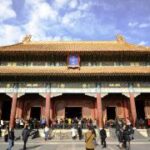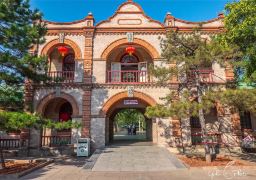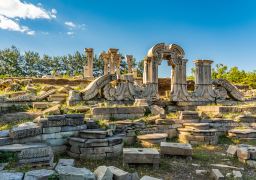Taihe Gate is the main entrance to the outer court of the Forbidden City, constructed during the Yongle period of the Ming Dynasty and originally named Fengtian Gate. It was renamed Huangji Gate during the Jiajing era and later changed to Taihe Gate after the Qing Dynasty took control of the Central Plains. Taihe Gate is considered one of the highest standard gates in ancient China, being one of the Five Gates of the Son of Heaven.
Inside the gate lies the Hall of Supreme Harmony, commonly referred to as the ‘Golden Throne Hall’. During the Ming and Qing Dynasties, there was a system of ‘Audience at the Gate’ where the emperor would receive court officials’ homage and handle state affairs at the Taihe Gate, which was later moved to the Qianqing Gate in the Qing Dynasty. The Taihe Gate we see today was reconstructed after a fire during the Guangxu period of the Qing Dynasty. It is situated on a white marble base, and the pair of bronze lions in front of the gate, cast during the Ming Dynasty, are the largest pair of bronze lions in the Forbidden City. Between Taihe Gate and the Meridian Gate lies the spacious Taihe Gate Square, with the Golden Water River meandering from west to east, echoing with the Jingshan Hill behind, providing an environment for the emperor’s residence with mountains at the back and water in front. The five white marble bridges spanning the river are known as the Inner Golden Water Bridges. The central main bridge, known as the ‘Imperial Way Bridge,’ is exclusively for the emperor and features railings carved with dragon cloud column heads. The four side bridges have railings carved with the 24 solar terms column heads. The two bridges next to the main bridge are for the royal family and are called ‘Royal Bridges,’ while the outer two are for civil and military officials of the third rank and above, called ‘Rank Bridges.’ Opening times: November 1st to March 31st, Tuesday to Sunday, 08:30-17:00; April 1st to October 31st, Tuesday to Sunday, 08:30-16:30; Closed all day on Mondays throughout the year; New Year’s Day, Spring Festival, Qingming Festival, Labor Day, Dragon Boat Festival, Mid-Autumn Festival, and National Day, 08:30-17:00.Taihe Gate
Taihe Gate is the main entrance to the outer court of the Forbidden City, constructed during the Yon[...]









